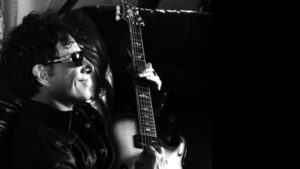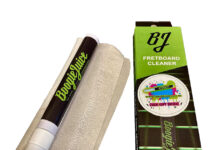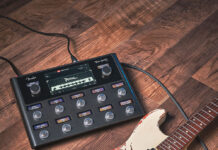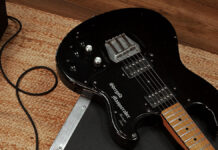
Journey’s Neal Schon On His Blues Roots, Playing PRS Guitars & Working With Yngwie Malmsteen
If you’re a classic rock fan, when you hear the name Neal Schon, you most likely think of Journey. Schon co-founded the band in 1973 and is the only member to have participated on all of its albums and tours. The group has sold over 75 million albums worldwide, and is still playing arenas in 2018; its 58-city co-headlining tour with Def Leppard kicks off in May.
But Journey has been only one part of Schon’s career and legacy. Before Journey, Schon played in Santana, having joined the group at the age of 15. When Journey was on break, Schon was part of Bad English, which had a number one hit with “When I See You Smile.” After Bad English’s breakup, he was the lead guitarist and producer behind Hardline, which charted with “Takin’ Me Down.” Schon’s discography also includes two albums with Miami Vice composer Jan Hammer, a full-length effort with Soul SirkUS, and assorted collaborations with Sammy Hagar, Joe Cocker, The Allman Brothers Band and Michael Bolton.
Beyond the aforementioned tour alongside Def Leppard, 2018 also brings Neal Schon’s Journey Through Time. Taking place on February 9, 2018 in San Francisco, Schon will be regrouping with original Journey and Santana member Gregg Rolie—as well as Marco Mendoza and former Journey member Deen Castronovo—for an intimate performance to benefit North Bay Fire Relief. This will be the first time that Schon and Rolie have performed together in two decades, and promises to feature rarely-performed songs from the Journey catalog.
Guitar World recently sat down with Schon to discuss the benefit show, how he got his start in the business and how he ended up with working with Yngwie Malmsteen.
One of the things I find most interesting about you is that you first became prominent as a guitarist in your teenage years. Since then you have worked consistently and in a variety of bands. Did you ever have a day job?
I had one day job and one summer job. I worked in Hollister, CA where I grew up after my folks first moved out from the East Coast. I decided that I was going to box garlic in Gilroy one summer because I wanted a mini-bike, and that’s what I had to do to get $100. I crated garlic with my cousins down there.
Then when I was 12, I had a job that I got that I think paid $1.25 or $1.50 an hour—because I was underage—at a bicycle shop, ripping apart bicycles and putting them back together. The guy was really particular on what parts he wanted me to do first. I felt like I had it down, and I realized that I didn’t like taking orders at that point. I was going to have to figure out something where I can make my own rules and be my own boss, so I said, “I’m going to be a musician. That’s what I feel like I want to do.” That way I can run my own life and someone doesn’t run it for me.
Were you playing instruments before guitar?
I was. I was playing woodwind instruments. My dad was a composer and his main instrument was tenor sax, and he was a leader of a big band and did big band arrangements. I started playing piano when I was six, and I actually liked the piano, but there were so many things going on when I was six. Now I’m playing more and more piano and composing with it for guitar.
Then I started playing in elementary school band. There’s no guitar in those bands, so I started playing tuba, which sucked (laughs). I gave it up and I played clarinet for a second and I didn’t like it. I started playing oboe in high school. I got first seat, where I got to play a couple of solos, but it really wasn’t my thing. It’s a very difficult instrument to play, and I think it’s one of the reasons I have a big neck, you have to blow and the muscles are contracted and nothing gets through that little reed. A beautiful instrument, but it just wasn’t something I wanted to pursue.
My dad bought me my first record, which was The Beatles’ Rubber Soul, and I was already listening to them on the radio, amongst everything else that was on the radio. There wasn’t a lot that I was really digging. My mom was always playing and singing too, they were always playing jazz around the house. It was either Ella Fitzgerald, Duke Ellington, Miles [Davis], all those old greats. I started listening to Wes Montgomery, Larry Coryell, John McLaughlin. All of the sudden, I was playing blues and really understood it and got deep in it.
I loved Michael Bloomfield from the Bay Area here, as well as B.B. [King], who I met with Elvin Bishop. That was my first big show, at the Fillmore West. I had been playing with Elvis Bishop for about a year at the old Keystone Korner in San Francisco. One night he goes, “You know, I’m going to take you for a treat tonight and we’re going to go to Fillmore West. We’re going to jam with B.B., I’m going to introduce you to B.B.” Bill Graham was there, I met Bill Graham that night.
All of the sudden, I’m up on-stage, looking out, and B.B.’s on the right, and it comes time when he goes, ‘Let’s see what this little sucker has.’ (laughs) I had studied him, you know? His vibrato, his choice of notes, and he’d play a riff instead of [something else). A lot of guitarists try to upstage, and it really comes off as kind of stupid. I said, ‘I’m going to pay due respect to him. When he plays me a riff, I’m gonna play it back and add a little something.’ He had a big smile on his face and it went back and forth for about five minutes. We remained friends after that, and the same with Albert King after that. I played with Buddy Guy in Chicago at his old club, with Junior Wells, and a host of other blues artists.
But then I was listening to all the original records, like Howlin’ Wolf and Muddy Waters and everything else I could find. I loved it, you know? Then that British electrified blues movement came, where they were taking that old American blues and electrifying it. I heard [Jimi] Hendrix on the radio and I was like, “What the f**k is that?” (laughs) It’s like, ‘That’s what I want to do.’ I was already listening to Clapton when he was with John Mayall and the Bluesbreakers. I loved his playing, so Cream was a no-brainer for me, I loved that stuff.
At that point, after studying older blues, I had all the records, I went from Are You Experienced? to Wheels Of Fire and Disraeli Gears. The first three Hendrix records, as they came, but I kind of flip-flopped from night to night. I pulled the arm up on the record player so I was listening to either Cream or Hendrix, even when I went to sleep. I found that I was learning in my sleep, because when the arm’s up it just keep repeating and repeating. Even though you don’t know where the fingers go, you’re familiar with it by listening.
It sounds like you were mentored by some guitar greats, but are there any players today who you look at as being modern guitar greats?
Oh, man, there are so many great guitarists today. I just played with one of my good friends, Joe Satriani, John Petrucci and Phil Collen from Def Leppard the other night when they played over in Oakland at the theater. I went and jammed with them and had a great time. But I love Satch, I love [Steve] Vai, I love Eric Johnson and John Petrucci. There’s so many great players, it’s just like, ‘What’s your taste? What do you want to hear?’
Over the years you’ve been known to play Fenders and Gibsons, but I believe you’re exclusive with Paul Reed Smith these days. How did that happen?
Paul and I have been friends forever, from when he first started making guitars, and I believe Carlos [Santana] had bought one of his first guitars that was handmade. I believe I bought the second or third, which I believe he had gotten back from me because he wanted to put them in a museum. But I got the first-ever double-neck he made and bought a couple of double-cuts. There were sort of SG-type double-cuts, not the double-cuts he’s making now.
Over the years he came up with some revolutionary ideas incorporating semi-hollow guitars with all kinds of crazy shit. Most people looked at him when he first came out like, ‘That doesn’t make any sense.’ But actually it makes guitars sound better. It became any kind of thing you wanted to make it.
Paul and I have done some amazing stuff together, but I don’t have an exclusive contract right now. I’m playing everything. I’m looking at eight Les Pauls that I brought to the house here that are Les Paul Ultima “Tree Of Life” guitars. There are a couple of them that I picked up that sound amazing because I felt like I’m going to do this gig on the 9th in San Francisco, and I was playing nothing but Les Pauls back then. Even though those guitars sound good, I’ll probably mix it up. I played a Tele the night I played with Satch at the guys. So I’m playing Fenders, PRS and Gibsons, all sorts of guitars.
One of my favorite projects that you worked on was Hear ‘N Aid and I’m wondering if you had positive memories of working on the “Stars” single.
I absolutely did. I didn’t think I was going to make that session because I had forgotten about it. In the older days I was hanging out and partying all night with friends here (laughs). So I remember calling up Ronnie [James Dio] in the morning and saying, ‘Ronnie, I haven’t been to bed yet and I doubt I’m going to make it.’ He said, ‘Oh, no, you have to come. You’re one of my main guitar players I really want on this record.’ He really pleaded with me until I said, ‘Okay, I will.’ I said, ‘But you’ve got to get me in and out. I can’t wait in a long line to play. I’ll just come in quick and I’ll do two takes, from beginning to end, pick whatever one you like and I’m out of there, and I’m going to go back home and go to sleep.’ He said okay.
So I got down to L.A., from San Francisco, and I brought my guitar—I think a ’63 Strat—and a little Boss pedal for distortion. They had some Marshalls there. They had me right down next to Yngwie [Malmsteen]. Brad Gillis was in the studio cutting the song before myself, and he was doing a lot of punching. It sounded really good but I was impatient. I wanted to get in and out of there and get to sleep because I was tired (laughs).
I told Yngwie, ‘I’m going to go in there and play two takes from beginning to end and then I’m out.’ So that’s what I did, but Ronnie loved what I did. I was in and out, it was a really easy session. I loved playing on something at that time period that, I was getting looks when I walked in the room. I do remember I was getting a lot of attitude from all of the guitarists, except Yngwie. He was very cool to me. I’m thinking, ‘This is weird,’ because everyone is saying really obnoxious things about this guy and I’m meeting him and I actually like him a lot.
George Lynch I appreciated as a guitar player back then, and he asked me if he could use the pedal I had back then and I said sure. He was in there, I hung out until George was done. He was struggling to get a sound, so he gets the pedal and says, ‘That helps a lot.’ That was it, but Ronnie was a great guy. It was a fun session and I loved getting to show all the other guitars that I can play any of that stuff as well.
Source: www.guitarworld.com











